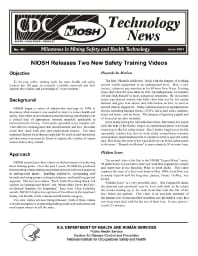Mining Publication: Technology News 491 - NIOSH Releases Two New Safety Training Videos
Original creation date: June 2001
Authors: ET Cullen
NIOSHTIC2 Number: 20021625
U.S. Department of Health and Human Services, Public Health Service, Centers for Disease Control and Prevention, National Institute for Occupational Safety and Health, Technology News 491, 2001 Jun :1-2
To develop safety training tools for mine health and safety trainers that fill gaps in currently available materials and help capture the wisdom and knowledge of "expert miners." NIOSH began a series of stakeholder meetings in 1998 to determine what research was needed to improve miner health and safety. One of the more common concerns among stakeholders was a critical lack of appropriate training materials applicable to metal/nonmetal mining. Participants provided many insights into what effective training materials should include and how materials could best reach both new and experienced miners. The most important factors were that any materials be realistic and interesting and that some way must be found to capture the wisdom of expert miners before they retired. NIOSH researchers chose videos as the best means of achieving these training goals. Over the past 3 years, NIOSH has produced three training videos that present information on safe work practices in underground mines: handling explosives, recognizing roof hazards and using proper scaling techniques, and installing ground supports. The last two videos, "Rock Falls--Preventing Rock Fall Injuries in Underground Mines" and "Miner Mike Saves the Day-or--Ground Support...It's Important," have won Alice Hamilton awards, NIOSH's highest recognition of Excellence in Occupational Safety and Health, in the Educational Materials category. Two new videos are now being released. Both of these videos were shot completely in operating underground hard-rock mines and used expert miners to tell the story. The first, "Hazards in Motion," deals with the dangers of working around mobile equipment in an underground mine. Ben, a new trainee, refuses to pay attention in his 40-hour New Miner Training class, and when the class takes its first trip underground, he wanders off and finds himself in many dangerous situations. He encounters many experienced miners who both chew him out for his unsafe attitude and give him advice and information on how to survive around mobile equipment. Many common pieces of equipment are shown, including haulage trucks, LHD's, tracks and trains, slushers, skips and hoists, and air doors. The dangers of ignoring signals and of horseplay are also included. After nearly losing his life numerous times, Ben learns his lesson with the help of the Safety Angel, an experienced miner who looks suspiciously like his safety trainer. Ben's Safety Angel saves his life repeatedly, teaches him how to work safely around these common conveyances, and introduces him to experts who have specific safety tips. Ben learns the error of his ways and vows to be the safest miner in the mine. "Hazards in Motion" is approximately 30 minutes long. The second video is the first in the NIOSH "Expert Miner" series. "Hidden Scars" is a narrative interview with Don Capparelli, a miner and supervisor at the Sunshine Mine in north Idaho. This video captures the story of a fatal rock burst in May 1994, when Don was seriously injured and his long-time partner, Jimmy Findley, was killed. "Hidden Scars" is a very powerful story. Don Capparelli shares the physical and emotional pain he lives with daily as he relates the events leading up to the rock burst that took the life of his best friend and partner. This video is an excellent reminder of the human cost of uncontrolled accidents and the hidden scars that survivors must deal with for the rest of their lives. It runs approximately 25 minutes.

NIOSHTIC2 Number: 20021625
U.S. Department of Health and Human Services, Public Health Service, Centers for Disease Control and Prevention, National Institute for Occupational Safety and Health, Technology News 491, 2001 Jun :1-2